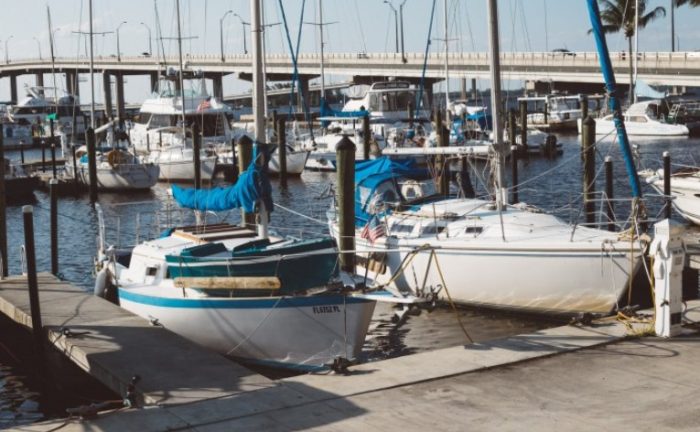When a boat is parked, it is docked, anchored, tied off, or moored. Depending on where the boat is parked the name changes. For example, if a boat is parked in a marina or a harbor then it is called a “moored boat.” If the boat is anchored in a body of water then it is called an “anchored boat.”
Key Takeaways
- Docking refers to pulling your dock parallel to a dock and using ropes called dock lines and nautical knots to fasten it
- Mooring refers to tying or securing your boat to a fixed object, for instance, a mooring buoy
- There are different equipment used when mooring your boat like an anchor, chain, mooring buoy, etc.
- If your anchor ride is long enough then you can anchor your boat anywhere
Difference between dock, anchor, moor, tie off

As part of the skills of a good captain, you have to learn different options of putting to a halt or breaking boating activities when need be. You may need to swim, take a break and probably fish, or enjoy the place’s scenery. You may also need to take a long break, like in the winter season. Let’s dive right into seeing which options you have.
1. Docking
The first term that we will look at is docking. Docking refers to pulling your dock parallel to a dock and using ropes called dock lines and nautical knots to fasten it. A docked boat will be close enough to shore and will be tied to a fixed structure called a dock so that you can step out into dry land from it. You will need other equipment apart from dock lines when you dock your boat. You will need fenders to protect your boat, other boats, and even the dock. These fenders are made of plastic or rubber, and they vary in size depending on the vessel for which they should act as a buffer, and about 5 should be enough.
Docking will ensure that you have an easy time when loading and unloading. Also, cleaning and maintenance will be easy, especially if you plan to dock for a long time, for instance, during winter break.
2. Mooring
Mooring refers to tying or securing your boat to a fixed object, for instance, a mooring buoy. This will mean that you can get to this fixed object and moor there instead of anchoring just anywhere. You will most certainly share this object with other users and get enough space for the width of your boat. If you are a beginner, the mooring may be challenging, but you will get it with enough practice.
When mooring your boat, no matter where all you need is a hook or line to help you attach the boat to the mooring. Sometimes you may get that where you had planned to moor is full, so you can moor onto another boat, also known as rafting up. This, however, you should do only after the owner of the other boat has agreed to it. You could also do this if you wanted to socialize with them. There are different pieces of equipment used when mooring your boat. Let us take a look at them.
- Mooring anchor- this is simply an anchor placed in a specific position. Its function is to help keep your boat stable when mooring it.
- A mooring chain connects the mooring anchor to the mooring buoy. You should use three times the length of depth.
- Mooring buoy- this is a floater that connects to the mooring anchor and helps mark where the boat is moored.
3. Anchoring
Anchoring your boat means dropping a large weight attached to your boat into the water to ensure that your boat does not move. Technically, you can anchor your boat anywhere, provided that your anchor ride is long enough. Some yachts come with anchoring devices, so you do not have to worry about whether your ride is long enough. If your boat does not have a ready anchoring device, you should multiply the deepest water you plan to anchor in by eight to get just the right length of anchor ride. However, before deciding to anchor, you have to do some research. For instance, the type of seabed varies, determining which type of anchor you should use. Depending on wind and tides, it will float around the anchor point when you anchor your boat.
4. Tying off
If you have tied off your boat, you have secured it to an object like a tree. This is mostly temporary, for example, if you went boating and stopped for a camp overnight. You have to be careful how you tie your knots when tying off. You don’t want to wake up and find out that your boat sailed off as you slept.
5. Berthing
Berthing is the whole process of moving your boat into a specific place called a berth. It involves maneuvering through the water up to when you come to half after your boat is properly ‘parked’ into the berth.
Things to remember when docking your boat

It’s hard and stressful for most beginners to dock a boat, and they need to learn a few tips that will guide them when docking. Below are some crucial tips to keep in mind while docking;
Determine wind and current
Before docking, be advised to determine the force of the wind and current to help you maintain control. Wind poses a threat to power boaters and sailors at the port when approaching a mooring. Ensure that you gauge the direction and force of the wind and decide whether you will overcome it or use it. On the current, it’s recommended that you approach a mooring against the current. The current direction and momentum will determine your safety. A strong current interferes with the control and can sweep away the small vessel, capsizing it and putting a crew in danger.
Take it slow
When docking your boat, take it at a slow speed to make it easier for you to steer. Sharp turns can be made when moving at a slow pace, and you can dock safely without hitting anything. Maintain a slow approach by taking your boat in and out of gear. Don’t see yourself as a genius and show people how efficiently you can hot-dog around and throttle because even captains with such skills are tipped up due to misjudging a distance, vector, or draft, causing a vessel to be a victim of its undirected momentum. A slow and steady approach shows a boater who is experienced in boating.
Talk to your crew
Before docking, talk to your passengers and warn them not to jump ship until the boat is safe and complete the docking maneuver. The boat can be misdirected when a passenger leaps off it, and it may result in an accident, move away from the docking or lengthen the distance.
Position the fenders
Fenders isolate the boat and the dock to prevent damage when docking. Place them properly sideways to prevent them from being caught under the pier. Please don’t use your passengers as fenders to push against the dock to reduce forward motion; such mishaps have led to some passengers losing their fingers and arms across the boating world.
Communicate a plan with your crew
Plan with your crew and assign tasks that you would wish them to perform. For example, assign a bowline to a competent passenger and another one to a stern or spring line. Assign other passengers to suspend fenders at the contact points to prevent your boat from being scratched or in case of a harder-than-expected landing. The arms and legs of your passengers should be inside the boat, especially at the pinch points between your boat and the dock. Your perfect planning with your passenger will lead to a perfect performance.
Consult a dockmaster
Is it safe to enter a port without knowing how it is? I bet not. Using VHF radio, talk to the dockmaster at the marina as you approach it to give you directions on how you’ll land. Get to know any available hindrances there which will limit your maneuvering.
Tie up your boat
Remember to park your boat parallel to the dock and tie it immediately to prevent drifting off. After that, switch off the engine.
Take away
If you love sailing, then some terms should be at your fingertips. If not, how will you communicate with other sailors? Having discussed the different terms you can use to mean that you have parked your boat, we are confident that you won’t confuse other sailors next time you have a conversation. We have also given you tips to use when docking your boat. We hope that you found this helpful.
References:
https://www.quora.com/What-is-it-called-when-a-boat-is-parked
https://vanislemarina.com/anchoring-mooring-docking/

Rockey is a kayaking enthusiast who has been kayaking with a local group for the last five years. He loves using kayaks while out on outings on the water or camping when the friends want to have a BBQ party somewhere on the bank of a local lake. More About James R Rockey at About Page Here: Authors
Based on his experiences with the different types of kayaks, he is sharing his opinion about kayaking tricks and required gears so that a beginner can get started right away.
Find his team on Twitter here. Happy reading!
